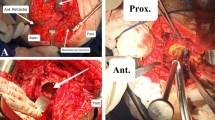Abstract
Introduction
We performed a retrospective outcome study on 23 consecutive acetabular reconstructions involving impaction bone grafting in Japanese patients.
Method
Two hips had cavitary defects, and 21 hips had combined segmental and cavitary defects. The mid-term follow-up was performed at a mean of 5.5 years postoperatively. The mean Merle d’Aubigné and Postel hip score had improved from 11.5 to 15.7 points at the final follow-up. Two hips showed migration at 30 months after surgery, and one of these was a candidate for re-revision due to symptomatic cup migration.
Results
The Kaplan–Meier survival rate of the cup, with loosening and re-operation as the end points, was 91.3 and 95.7% at 5 years, respectively.
Conclusion
Acetabular impaction bone grafting is a reproducible technique in which surgeons should strictly follow the recommended technical procedure.





Similar content being viewed by others
References
Slooff TJJH, Huiskes R, van Horn J et al (1984) Bone grafting in total hip replacement for acetabular protrusion. Acta Orthop Scand 55:593–596
Slooff TJ, Buma P, Schreurs BW et al (1996) Acetabular and femoral reconstruction with impacted graft and cement. Clin Orthop Relat Res 324:108–115
Schreurs BW, Bolder SBT, Gardeniers JWM et al (2004) Acetabular revision with impacted morsellized cancellous bone grafting and a cemented cup: a 15- to 20-year follow-up. J Bone Joint Surg Br 86B:492–497
Comba F, Buttaro M, Pusso R et al (2006) Acetabular reconstruction with impacted bone allografts and cemented acetabular components: a 2- to 13-year follow-up study of 142 aseptic revisions. J Bone Joint Surg Br 88B:865–869
van Haaren EH, Heyligers IC, Alexander FGM et al (2007) High rate of failure of impaction grafting in large acetabular defects. J Bone Joint Surg Br 89B:296–300
D’Antonio JA, Capello WN, Borden LS et al (1989) Classification and management of acetabular abnormalities in total hip arthroplasty. Clin Orthop Relat Res 243:126–137
Gie GA, Linder L, Ling RS et al (1993) Impacted cancellous allografts and cement for revision total hip arthroplasty. J Bone Joint Surg Br 75B:14–21
Mandziak DG, Howie DW, Neale SD et al (2007) Cement-within-cement stem exchange using the collarless polished double-taper stem. J Arthroplasty 22:1000–1006
Merle d’Aubigné R, Postel M (1954) Functional results of hip arthroplasty with acrylic prosthesis. J Bone Joint Surg Am 36A:451–475
DeLee JG, Charnley J (1976) Radiological demarcation of cemented cups in total hip arthroplasty. Clin Orthop Relat Res 121:20–32
Hodgkinson JP, Shelley P, Wroblewski BM (1988) The correlation between the roentgenographic appearance and operative findings at the bone-cement junction of the cup in Charnley low friction arthroplasties. Clin Orthop Relat Res 228:105–109
Kaplan EL, Meier P (1958) Nonparametric estimation from incomplete observations. J Am Stat Assoc 53:457–481
Whaley AL, Berry DJ, Harmsen WS (2001) Extra-large uncemented hemispherical acetabular components for revision total hip arthroplasty. J Bone Joint Surg Am 83A:1352–1357
Ito H, Matsuno T, Aoki Y et al (2003) Acetabular components without bulk bone graft in revision surgery: a 5- to 13-year follow-up study. J Arthroplasty 18:134–139
Abeyta PN, Namba RS, Janku GV et al (2008) Reconstruction of major segmental acetabular defects with an Oblong-shaped cementless prosthesis. A long-term outcomes study. J Arthroplasty 23:247–253
Kerboull M, Hamadouche M, Kerboull L (2000) The Kerboull acetabular reinforcement device in major acetabular reconstructions. Clin Orthop Relat Res 378:155–168
Tanaka C, Shikata J, Ikenaga M et al (2007) Acetabular reconstruction using a Kerboull-type acetabular reinforcement device and hydroxyapatite granules. a 3- to 8-year follow-up study. J Arthroplasty 18:719–725
Kawanabe K, Akiyama H, Onishi F et al (2007) Revision total hip replacement using the Kerboull acetabular reinforcement device with morsellized or bulk graft. Results at a mean follow-up of 8.7 years. J Bone Joint Surg Br 89B:26–31
Lunn JV, Kearns SS, Quinlan W et al (2005) Impaction allografting and the Kerboull acetabular reinforcement device: 35 hips followed for 3–7 years. Acta Orthop Scand 76:296–302
Gerber A, Pisan M, Zurakowski D et al (2003) Ganz reinforcement ring for reconstruction of acetabular defects in revision total hip arthroplasty. J Bone Joint Surg Am 85A:2358–2364
Gie GA (1999) Femoral bone grafting: intramedullary impaction grafting. In: Steinberg ME, Garino JP (eds) Revision total hip arthroplasty. Lippincott Williams & Wilkins, Philadelphia, pp 281–297
Bolder SBT, Schreurs BW, Verdonschot N et al (2003) Particle size of bone graft and method of impaction affect initial stability of cemented cups. Human cadaveric and synthetic pelvic specimen studies. Acta Orthop Scand 74:652–657
Dunlop DG, Brewster NT, Madabhushi SPG et al (2003) Techniques to improve the shear strength of impacted bone graft. The effect of particle size and washing of the graft. J Bone Joint Surg Am 85A:639–646
Board TN, Rooney P, Kay PR (2008) Strain imparted during impaction grafting may contribute to bony incorporation. An in vitro study of the release of BMP-7 from allograft. J Bone Joint Surg Br 90B:821–824
Manus U, Andereya S, Gravius S et al (2008) How to store autologous bone graft perioperatively: an in vitro study. Arch Orthop Trauma Surg 128:1007–1011
Enneking WF, Mindell ER (1991) Observations on massive retrieved human allografts. J Bone Joint Surg Am 73A:1123–1142
Hooten JP Jr, Engh CA, Heekin RS et al (1996) Structural bulk allografts in acetabular reconstruction: analysis of two grafts retrieved at post-mortem. J Bone Joint Surg Br 78B:270–275
van der Donk S, Buma P, Slooff TJJH et al (2002) Incorporation of morsellized bone grafts: a study of 24 acetabular biopsy specimens. Clin Orthop Relat Res 396:131–141
Author information
Authors and Affiliations
Corresponding author
Rights and permissions
About this article
Cite this article
Iwase, T., Masui, T., Torii, Y. et al. Impaction bone grafting for acetabular reconstruction: mean 5.5-year results in Japanese patients. Arch Orthop Trauma Surg 130, 433–439 (2010). https://doi.org/10.1007/s00402-009-0904-y
Received:
Published:
Issue Date:
DOI: https://doi.org/10.1007/s00402-009-0904-y




